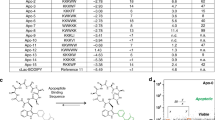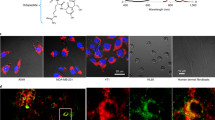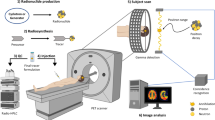Abstract
Apoptosis is a critical factor in AIDS and other viral illnesses, cerebral and myocardial ischemia, autoimmune and neurodegenerative states, organ and bone marrow transplant rejection, and tumor response to chemotherapy and radiation. Improved methods to identify sites of apoptosis are increasing our understanding of the pathophysiology and treatment of these and numerous other human disorders. Here we describe the most used method for labeling annexin V, a protein with a high affinity for apoptotic cells in vitro, with technetium-99m (99mTc) as a radionuclide imaging agent that can localize and non-invasively quantify apoptosis in vivo when coupled with single-photon emission tomography. In this method, annexin V is first attached to the bifunctional chelator molecule hydrazino nicotinate (HYNIC). Once prepared, HYNIC–annexin V can be labeled with 99mTc, a widely available γ-radiation-emitting radionuclide, for intravenous injection in as little as 30 min without the need for specialized reagents or equipment.
This is a preview of subscription content, access via your institution
Access options
Subscribe to this journal
Receive 12 print issues and online access
$259.00 per year
only $21.58 per issue
Buy this article
- Purchase on Springer Link
- Instant access to full article PDF
Prices may be subject to local taxes which are calculated during checkout

Similar content being viewed by others
References
Tait, J.F., Brown, D.S., Gibson, D.F., Blankenberg, F.G. & Strauss, H.W. Development and characterization of annexin V mutants with endogenous chelation sites for 99mTc. Bioconjug. Chem. 11, 918–925 (2000).
Tait, J.F., Gibson, D.F. & Smith, C. Measurement of the affinity and cooperativity of annexin V–membrane binding under conditions of low membrane occupancy. Anal. Biochem. 329, 112–119 (2004).
Abrams, M.J. et al. Technetium-99m–human polyclonal IgG radiolabeled via the hydrazino nicotinamide derivative for imaging focal sites of infection in rats. J. Nucl. Med. 31, 2022–2028 (1990).
Blankenberg, F.G. et al. In vivo detection and imaging of phosphatidylserine expression during programmed cell death. Proc. Natl. Acad. Sci. USA. 95, 6349–6354 (1998).
Verbeke, K. et al. Optimization of the preparation of 99mTc-labeled HYNIC-derivatized annexin V for human use. Nucl. Med. Biol. 30, 771–778 (2003)
Larsen, S.K., Caldwell, G., Higgins, J.D., Abrams, M.J. & Solomon, H.F. Technetium complex of tricine: useful precursor for the 99mTc labeling of hydrazino nicotinamide modified proteins. J. Labelled Compds. Radiopharm. 35, 1–2 (1994).
Liu, S. et al. Labeling a hydrazino nicotinamide-modified cyclic IIb/IIIa receptor antagonist with 99mTc using aminocarboxylates as coligands. Bioconjug. Chem. 7, 63–71 (1996).
Larsen, S.K., Solomon, H.F., Caldwell, G. & Abrams, M.J. [99mTc]Tricine: a useful precursor complex for the radiolabeling of hydrazinonicotinate protein conjugates. Bioconjug. Chem. 6, 635–638 (1995).
Tait, J.F., Smith, C. & Blankenberg, F.G. Structural requirements for in vivo detection of cell death with 99mTc–Annexin V. J. Nucl. Med. 46, 807–815 (2005).
King, T.P., Zhao, S.W. & Lam, T. Preparation of protein conjugates via intermolecular hydrazone linkage. Biochemistry 25, 5774–5779 (1986).
Ono, M. et al. Intracellular metabolic fate of radioactivity after injection of technetium-99m-labeled hydrazino nicotinamide derivatized proteins. Bioconjug. Chem. 10, 386–394 (1999).
Grierson, J.R. et al. Production of [F-18]fluoroannexin for imaging apoptosis with PET. Bioconjug. Chem. 15, 373–379 (2004).
Acknowledgements
This work was supported in part by grants from the National Institutes of Health (CA-102348 to J.T. and F.B., and EB000898 to F.B.).
Author information
Authors and Affiliations
Contributions
J.T. co-developed in vitro laboratory methods and co-wrote the article. J.-L.V. developed HYNIC–annexin V into a clinical kit for SPECT imaging and co-wrote the article. H.W.S. co-invented the use of HYNIC–annexin V for in vivo imaging of apoptosis and co-wrote the article.
Corresponding author
Ethics declarations
Competing interests
The authors declare no competing financial interests.
Rights and permissions
About this article
Cite this article
Blankenberg, F., Vanderheyden, JL., Strauss, H. et al. Radiolabeling of HYNIC–annexin V with technetium-99m for in vivo imaging of apoptosis. Nat Protoc 1, 108–110 (2006). https://doi.org/10.1038/nprot.2006.17
Published:
Issue Date:
DOI: https://doi.org/10.1038/nprot.2006.17
This article is cited by
-
Monitoring apoptosis and neuronal degeneration by real-time detection of phosphatidylserine externalization using a polarity-sensitive indicator of viability and apoptosis
Nature Protocols (2010)
-
Noninvasive optical imaging of apoptosis by caspase-targeted activity-based probes
Nature Medicine (2009)
-
Nuclear imaging of molecular processes in cancer
Targeted Oncology (2009)
-
Methods for MAG3 conjugation and 99mTc radiolabeling of biomolecules
Nature Protocols (2006)
Comments
By submitting a comment you agree to abide by our Terms and Community Guidelines. If you find something abusive or that does not comply with our terms or guidelines please flag it as inappropriate.



